Bomber_12th
SOH-CM-2025
First time taking the aircraft out, after studying the user guide, and I'm even more infatuated with this aircraft - I love the attention to detail on the engine start and management of it all, and the details of the graphics are fantastic.
Olderndirt, there are a few more steps than that in order to start the engine and keep it running. This is what the user guide describes, and it works brilliantly for me:
Engine Start
1. Fuel Tank - STARTING TANK (bottom right position on fuel tank selector)
2. Pressure Selector - HAND-DRIVEN (bottom left position on pressure selector)
3. Fuel Pressure Pump - HAND PUMP (back and forth) Until Pressure Gauge Needle is at Red Line
4. Ignition Adjustment - RETARD (rear/"Spat" position)
5. Magnetos - BOTH
6. Click Starter Crank (turns prop/engine starts)
7. Pressure Selector - MOTOR-DRIVEN (bottom right position on pressure selector)
8. Ignition Adjustment - NORMAL (forward/"Fruh" position)
9. Fuel Tank - MAIN TANK (bottom left position on fuel tank selector)
After the engine starts, you'll notice some moments later, that eventually the smoke from the engine clears and the starter hand crank resets and you're good to go!
(If you don't switch to the motor-driven pressure pump, the pressure in the fuel system won't remain and thus the engine will run out of fuel and quit (the motor-driven pump is a nice feature in WWI aircraft - a few of the rotary-powered examples, like the Avro 504, requires the pilot to continue to hand pump pressure to the fuel system at various intervals throughout all operations/flight, in order to keep the system pressurized - and those types, as with most WWI types, have a "fine adjustment" that has to be played around with as well, for different throttle settings, and the engine will quit at the wrong setting (either causing a lean-cut or a rich-cut) - all of this essentially making the pilot the engine's carburetor).)
There is no mixture-related control in the aircraft, so to shut the aircraft down, you start by turning the ignition/magnetos off, then fuel off (bottom fuel tank selection) and finally air pressure off (bottom pressure selection) or to the purge/exit position (top left pressure selection) to bleed-out the air pressure.
I haven't experienced any issues with the engine in the air yet (have been making sure to keep the RPM's down to proper level), but the engine will begin puffing out smoke and causing the RPM's to fluctuate if I spend any real amount of time taxiing after landing, which clears up as soon as I shut the engine off.
Olderndirt, there are a few more steps than that in order to start the engine and keep it running. This is what the user guide describes, and it works brilliantly for me:
Engine Start
1. Fuel Tank - STARTING TANK (bottom right position on fuel tank selector)
2. Pressure Selector - HAND-DRIVEN (bottom left position on pressure selector)
3. Fuel Pressure Pump - HAND PUMP (back and forth) Until Pressure Gauge Needle is at Red Line
4. Ignition Adjustment - RETARD (rear/"Spat" position)
5. Magnetos - BOTH
6. Click Starter Crank (turns prop/engine starts)
7. Pressure Selector - MOTOR-DRIVEN (bottom right position on pressure selector)
8. Ignition Adjustment - NORMAL (forward/"Fruh" position)
9. Fuel Tank - MAIN TANK (bottom left position on fuel tank selector)
After the engine starts, you'll notice some moments later, that eventually the smoke from the engine clears and the starter hand crank resets and you're good to go!
(If you don't switch to the motor-driven pressure pump, the pressure in the fuel system won't remain and thus the engine will run out of fuel and quit (the motor-driven pump is a nice feature in WWI aircraft - a few of the rotary-powered examples, like the Avro 504, requires the pilot to continue to hand pump pressure to the fuel system at various intervals throughout all operations/flight, in order to keep the system pressurized - and those types, as with most WWI types, have a "fine adjustment" that has to be played around with as well, for different throttle settings, and the engine will quit at the wrong setting (either causing a lean-cut or a rich-cut) - all of this essentially making the pilot the engine's carburetor).)
There is no mixture-related control in the aircraft, so to shut the aircraft down, you start by turning the ignition/magnetos off, then fuel off (bottom fuel tank selection) and finally air pressure off (bottom pressure selection) or to the purge/exit position (top left pressure selection) to bleed-out the air pressure.
I haven't experienced any issues with the engine in the air yet (have been making sure to keep the RPM's down to proper level), but the engine will begin puffing out smoke and causing the RPM's to fluctuate if I spend any real amount of time taxiing after landing, which clears up as soon as I shut the engine off.
Last edited:


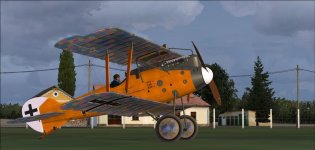
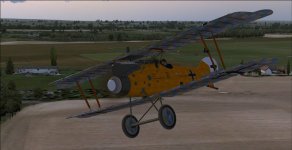
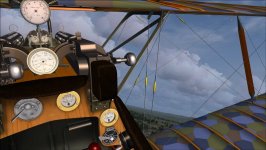
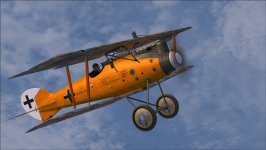
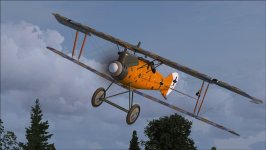















 Although I'm a Brit I seem to spend most of my time in ORBX PNW
Although I'm a Brit I seem to spend most of my time in ORBX PNW